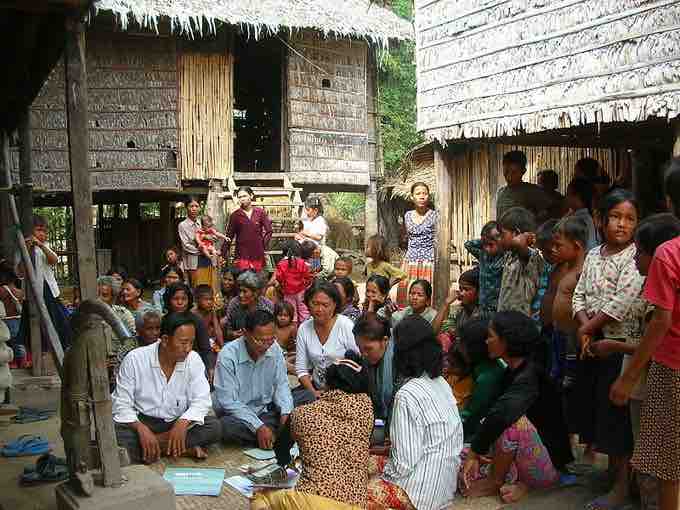Introduction

An Oral Community in Cambodia
An oral community in Takéo, Cambodia confronts writing. Modern scholarship has shown that orality is a complex and tenacious social phenomenon.
Orality is thought and verbal expression in societies where the technologies of literacy (especially writing and print) are unfamiliar to most of the population. The study of orality is closely allied to the study of oral tradition. However, it has broader implications.
In his publications Walter J. Ong, a key scholar in this field, distinguishes between two forms of orality: ‘primary orality' and ‘secondary orality'. In addition, he refers to 'oral residue' and 'residually oral cultures'.
Drawing on hundreds of studies from anthropology, linguistics and the study of oral tradition, Ong summarizes ten key aspects of the ‘psychodynamics of orality'. Ong draws his examples from both primary oral societies, and societies with a very high ‘oral residue'.
Formulaic Styling
Formulaic styling is to package complex ideas memorably for easy retention and recall.
To solve effectively the problem of retaining and retrieving carefully articulated thought, one must think in mnemonic patterns, shaped for ready oral recurrence. Thoughts must come into being in heavily rhythmic, balanced patterns, in repetitions or antithesis, in alliterations or assonances, in epithetic and other formulary expressions.
Anthropologist Marcel Jousse identifies a close linkage between rhythm and breathing patterns, gestures, and the bilateral symmetry of the human body in several ancient verse traditions. This synergy between the body and the construction of oral thought further fuels memory.
Additive Rather Than Subordinative
Oral cultures avoid complex ‘subordinative' clauses. Ong cites an example from the Douay-Rheims version of Genesis (1609–10), noting that this basic additive pattern (in italics) has been identified in many oral contexts around the world:
In the beginning God created heaven and earth. And the earth was void and empty, and darkness was on the face of the deep; and the spirit of God moved over the waters. And God said …
Demonstrating how oral modes of communication tend to evolve into literate ones, Ong additionally cites the New American Bible (1970), which offers a translation that is grammatically far more complex:
In the beginning, when God created the heavens and the earth, the earth was a formless wasteland, and darkness covered the abyss, while a mighty wind swept over the waters. Then God said …
Aggregative Rather Than Analytic
Oral expression brings words together in pithy phrases that are the product of generations of evolution: the ‘sturdy oak tree', the ‘beautiful princess', or ‘clever Odysseus'. The words are brought together out of habit during general communication. Analyzing or breaking apart such expressions adds complexity to communications, and questions received wisdom.
Redundant or Copious
Speech that repeats earlier thoughts or thought-pictures, or shines a different light on them somehow, helps to keep both the speaker and the listener focused on the topic, and makes it easier for all to recall the key points later. Oral cultures encourage fluency, fulsomeness, volubility. Rhetoricians were to call this copia.
Conservative or Traditionalist
Because oral societies have no effective access to writing and print technologies, they must invest considerable energy in basic information management. Storage of information, being primarily dependent on individual or collective recall, must be handled with particular thrift. It is possible to approximately measure oral residue from the amount of memorization the culture's educational procedures require.
This creates incentives to avoid exploring new ideas, and particularly to avoid the burden of having to store them. It does not prevent oral societies from demonstrating dynamism and change, but there is a premium on ensuring that changes cleave to traditional formulas, and are presented as fitting the traditions of the ancestors.
Close to the Human Lifeworld
Oral cultures take a practical approach to information storage. To qualify for storage, information must usually concern matters of immediate practical concern or familiarity to most members of the society.
By contrast, only literary cultures have launched phenomenological analyses, abstract classifications, ordered lists and tables, etc. Nothing analogous exists in oral societies.
Agonistically Toned
Beowulf fights the dragon: the oral world is agonistic.
Agonistic means ‘combative', but Ong actually advances a deeper thesis with this point. Writing and to an even greater extent print, he argues, disengage humans from direct, interpersonal struggle.
Empathetic and Participatory
In an oral culture the most reliable and trusted technique for learning is to share a "close, empathetic, communal association" with others who know.
Homeostatic
Oral societies conserve their limited capacity to store information, and retain the relevance of their information to the interest of their present members, by shedding memories that have lost their past significance.
Situational Rather Than Abstract
In oral cultures, concepts are used in a way that minimizes abstraction, focusing to the greatest extent possible on objects and situations directly known by the speaker.